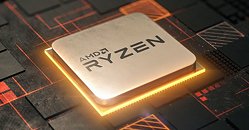Thursday, July 26th 2018

No 16-core AMD Ryzen AM4 Until After 7nm EPYC Launch (2019)
AMD in its Q2-2018 investors conference call dropped more hints at when it plans to launch its 3rd generation Ryzen processors, based on its "Zen2" architecture. CEO Lisa Su stated in the Q&A session that rollout of 7 nm Ryzen processors will only follow that of 7 nm EPYC (unlike 1st generation Ryzen preceding 1st generation EPYC). What this effectively means is that the fabled 16-core die with 8 cores per CCX won't make it to the desktop platform any time soon (at least not in the next three quarters, certainly not within 2018).
AMD CEO touched upon the development of the company's 7 nm "Rome" silicon, which will be at the heart of the company's 2nd generation EPYC processor family. 2nd generation EPYC, as you'd recall from our older article, is based on 7 nm "Zen2" architecture, and not 12 nm "Zen+." 3rd generation Ryzen is expected to be based on "Zen2." As of now, the company is said to have completed tape-out of "Rome," and is sending samples out to its industry partners for further testing and validation. The first EPYC products based on this will begin rolling out in 2019. The 7 nm process is also being used for a new "Vega" based GPU, which has taped out, and will see its first enterprise-segment product launch within 2018.With "Zen 2" based client-segment product being slated for 2019, there doesn't appear to be any immediate counter from AMD to Intel's 14 nm 8-core "Whiskey Lake" silicon; beyond maybe launching existing 12 nm "Pinnacle Ridge" based products with higher clocks, or lowering prices. The company will be launching its 2nd generation Ryzen Threadripper processors within 2018, but those are HEDT products not designed to compete with "Whiskey Lake." Any interim new 12 nm "Zen+" silicon with >8 cores would go against what Dr. Su stated in her Q&A, and is hence unlikely. "Rome" was the only CPU development mentioned by Dr. Su.
Source:
AMD
AMD CEO touched upon the development of the company's 7 nm "Rome" silicon, which will be at the heart of the company's 2nd generation EPYC processor family. 2nd generation EPYC, as you'd recall from our older article, is based on 7 nm "Zen2" architecture, and not 12 nm "Zen+." 3rd generation Ryzen is expected to be based on "Zen2." As of now, the company is said to have completed tape-out of "Rome," and is sending samples out to its industry partners for further testing and validation. The first EPYC products based on this will begin rolling out in 2019. The 7 nm process is also being used for a new "Vega" based GPU, which has taped out, and will see its first enterprise-segment product launch within 2018.With "Zen 2" based client-segment product being slated for 2019, there doesn't appear to be any immediate counter from AMD to Intel's 14 nm 8-core "Whiskey Lake" silicon; beyond maybe launching existing 12 nm "Pinnacle Ridge" based products with higher clocks, or lowering prices. The company will be launching its 2nd generation Ryzen Threadripper processors within 2018, but those are HEDT products not designed to compete with "Whiskey Lake." Any interim new 12 nm "Zen+" silicon with >8 cores would go against what Dr. Su stated in her Q&A, and is hence unlikely. "Rome" was the only CPU development mentioned by Dr. Su.

29 Comments on No 16-core AMD Ryzen AM4 Until After 7nm EPYC Launch (2019)
Global Foundries 14nm wasn't thought to be an especially "fast" process to begin with. It may be PR fluff, but they are touting clock speed approaching five gigahertz for 7nm. We will see. Luckily for AMD they will have TSMC fabbing at least some of the Zen 2 cores. Having said all that there are no guarantees, but it's difficult for me to imagine anyone saying out of hand that there will be no clock speed improvements
Well this is the exact reason why we won't see ICL anytime soon. The max (OCed) speeds on CFL ensure that Intel cannot releases a successor with little to no improvements, IPC or clocks, hence the recurring delays.
FX-9590 is 5 years old so AMD had a good bit of time to work on Zen which is understandable because they had to do all the core development for the multichip arch.
Like I mentioned in another thread, I don't think making a more heavily multithreaded chip really makes much sense at the moment for the desktop market. The limitations of current frequency dual channel memory and the fact that only workstation and server workloads are optimised enough at the moment means that a significantly larger chip will not really have a good place in the market.
And yeah I doubt 10nm will be coming to the desktop platform any time soon, it might end up being a bit like broadwell was.